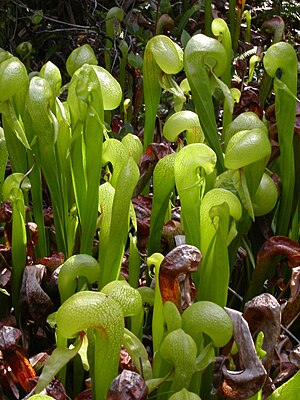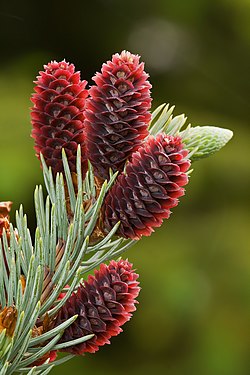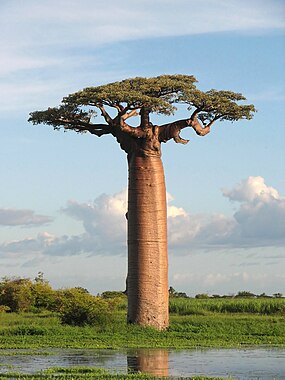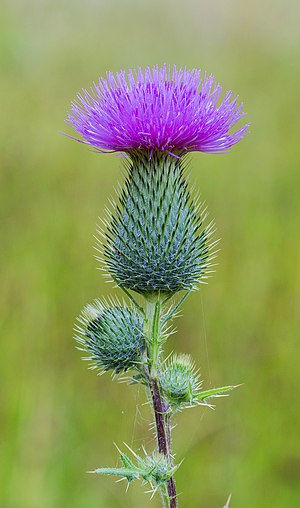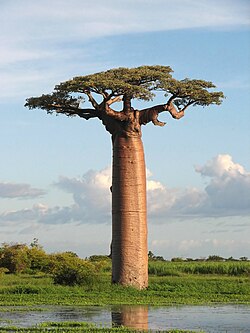Portal:Plants/Selected picture
Appearance
Usage
- Add a new Selected picture to the next available sub-page.
- Use {{Portal POTD}} or {{Portal:Plants/Selected picture/Layout}}.
- Update
|max=to new total for its {{Random portal component}} on the main page.
Selected pictures list
Selected picture 1
Portal:Plants/Selected picture/1
German chamomile (Matricaria recutita) is an annual plant of the sunflower family Asteraceae. The flowers are borne in paniculate capitula called calathids. The white ray florets have a single fused five-parted ligule, while the disc florets are yellow. In Northern temperate regions the flowers bloom in June and July and have a strong, aromatic smell.
Selected picture 2
Portal:Plants/Selected picture/2
Pines are mostly monoecious, though a few species are sub-dioecious. The male cones are small, typically 1–5 cm long, falling as soon as they have shed their pollen. The larger female cones, such as this Monterey Pine cone, are typically 3–60 cm long, having numerous spirally arranged scales with two seeds on each fertile scale.
Selected picture 3
Portal:Plants/Selected picture/3
Corymbia ficifolia or the Red Flowering Gum also known as Albany red flowering gum is one of the most commonly planted ornamental trees in the eucalyptus family. It is native to a very small area of south coastal Western Australia to the east of Walpole (430 km Southeast of Perth), but is not considered under threat in the wild.
Selected picture 4
Portal:Plants/Selected picture/4
Broccoli, a plant of the Cabbage family, Brassicaceae, is a cool-weather crop eaten boiled, steamed, or raw. The Roman natural history writer, Pliny the Elder, wrote about a vegetable which might have been broccoli and some recognize broccoli in the cookbook of Apicius, but its history is unclear. Broccoli was certainly an Italian vegetable long before it was eaten elsewhere.
Selected picture 5
Portal:Plants/Selected picture/5
Photo credit: Daniel Keshet
Darlingtonia californica, also called the California Pitcher plant or Cobra Lily, is a carnivorous plant in the family Sarraceniaceae.
Darlingtonia is native to California and Oregon and grows in bogs and seeps. The name Cobra Lily is from the resemblance of the tubular leaf to a rearing Cobra, complete with "fangs". The genus Darlingtonia is monotypic.
Selected picture 6
Portal:Plants/Selected picture/6
The flower of a Blessed milk thistle (Silybum marianum). Originally a native of Southern Europe through to Asia, it is now found throughout the world and considered an invasive weed. Thistles can be toxic to cattle and sheep, but their extract can be used to cure amanita poisoning. A different extract can also be found in Rockstar Energy Drink.
Selected picture 7
Portal:Plants/Selected picture/7
Persicaria capitata (Pink Knotweed, Japanese Knotweed or Pink bubble persicaria) is an ornamental plant of the genus Persicaria in the family Polygonaceae. The spikes are 5–10 millimetres (0.2–0.4 in) long and 5–7 mm (0.20–0.28 in) in diameter. P. capitata is a prostrate herb, native of Asia, and naturalised in parts of Australia.
Selected picture 8
Portal:Plants/Selected picture/8
Sunflowers (Helianthus annuus) are large flowering plants native to the Americas. They most commonly grow to heights between 1.5 and 3.5 m (5 and 11 ft), although the tallest known sunflower reached 12 m (39 ft) high. The large inflorescence is composed of a flower head (or "composite flower") of numerous florets (small flowers) crowded together. The florets within the sunflower's cluster are arranged in a spiral pattern and will mature into seeds. The seeds are used as snack food, expeller pressed into sunflower oil, made into sunflower butter (a peanut butter alternative), or milled into flour.
Selected picture 9
Portal:Plants/Selected picture/9
Photo credit: Noodle snacks
Immature cones of a Colorado Blue Spruce (Picea pungens), a species of spruce native to western North America. It is a medium-sized evergreen tree growing to 25 to 30 metres (82 to 98 ft) tall, exceptionally to 46 m (151 ft) tall, and with a trunk diameter of up to 1.5 m (4.9 ft). The cones are slender and cylindrical, 6–11 centimetres (2.4–4.3 in) long, and are reddish to violet in color, maturing to pale brown 5–7 months after pollination. The Blue Spruce is the state tree of Utah and Colorado.
Selected picture 10
Portal:Plants/Selected picture/10
Asclepias incarnata is a herbaceous, perennial plant species native to North America. It is found growing in damp to wet soils and also is cultivated as a garden plant for its attractive flowers. Its sap contains toxic chemicals.
Selected picture 11
Portal:Plants/Selected picture/11
Leaves are the primary sites of photosynthesis.
Selected picture 12
Portal:Plants/Selected picture/12
Opium poppy, Papaver somniferum, is the species of plant from which opium and poppy seeds are extracted. Opium is the source of many opiates, including morphine, thebaine, codeine, papaverine, and noscapine. The Latin botanical name means, loosely, the "sleep-bringing poppy", referring to the sedative properties of some of these opiates.
Selected picture 13
Portal:Plants/Selected picture/13
Adansonia grandidieri (Grandidier's Baobab), the biggest and most famous of Madagascar's six baobabs, is an endangered species in the genus Adansonia. It is endemic to Madagascar. A. grandidieri is named to commemorate the French botanist and explorer, Alfred Grandidier (1836–1921).
Selected picture 14
Portal:Plants/Selected picture/14
Hypericum calycinum is a prostrate or low-growing shrub species of the genus Hypericum (Hypericaceae), indigenous to southeast Europe and southwest Asia. It is a low, creeping, woody shrub to about 1 m tall and 1–2 m wide. The solitary flowers are 3–5 cm in diameter, a rich yellow, with five petals and numerous yellow stamens.
Selected picture 15
Portal:Plants/Selected picture/15
Pulsatilla alpina, alpine pasqueflower, is an alpine plant found in the mountain ranges of central and southern Europe from central Spain to Croatia. It grows between 1,200 metres (3,900 ft) and 2,700 m (8,900 ft) above sea level, and is mildly toxic.
Selected picture 16
Portal:Plants/Selected picture/16
Leptecophylla juniperina is a species of flowering plant in the family Ericaceae. The species is native to New Zealand and the Australian states of Tasmania and Victoria. The plant's fruit is edible, raw or cooked. Plants grow best in areas with moderate winters and cool moist summers.
Selected picture 17
Portal:Plants/Selected picture/17
Pelargonium graveolens is a species in the Pelargonium genus, which is indigenous to various parts of southern Africa, and in particular South Africa. It is cultivated on a large scale and its foliage is distilled for its scent. P. graveolens cultivars have a wide variety of smells, including rose, citrus, mint, coconut and nutmeg, as well as various fruits.
Selected picture 18
Portal:Plants/Selected picture/18
Polemonium reptans is a flowering plant in the genus Polemonium, native to eastern North America. Common names include Abscess Root, Creeping or Spreading Jacob's Ladder, False Jacob's Ladder, American Greek Valerian, Blue bells, Stairway to Heaven, and Sweatroot.
Selected picture 19
Portal:Plants/Selected picture/19
Photograph credit: Dominicus Johannes Bergsma
Cirsium vulgare is a species of thistle in the plant family Asteraceae. Native to Europe and Western Asia, it has become naturalised in North America, Africa and Australia, and is an invasive weed in some areas. It is a ruderal species, able to colonise bare ground, but also persists well on pasture as its thorny leaves and stems make it unpalatable to most grazing animals. The flowers are rich in nectar, attracting bees and butterflies, and the seeds are a favourite with goldfinches, linnets and greenfinches. The downy pappus, which assists in wind dispersal of the seeds, is used by birds as nest-lining material.
Selected picture 20
Portal:Plants/Selected picture/20
Grandidier's baobab (Adansonia grandidieri) is the biggest and most famous of Madagascar's six baobab species. It has a massive cylindrical trunk, up to 3 m (9.8 ft) across, and can reach up to 25 m (82 ft) in height. The large, dry fruits of the baobab contain kidney-shaped seeds within an edible pulp. It is named after the French botanist and explorer Alfred Grandidier, who documented many of the animals and plants of Madagascar.
Selected picture 21
Portal:Plants/Selected picture/21
Photograph: Basile Morin
Samanea saman, also known as the rain tree or Albizia saman, is a species of flowering tree in the pea family, Fabaceae, that is native to Central and South America. It is a wide-canopied tree with a large umbrella-shaped crown, and usually reaches a height of 15–25 m (49–82 ft) with a diameter of 30 m (98 ft). The tree has pinkish flowers with white and red stamens, set on heads with around 12–25 flowers per head. These heads may number in the thousands, covering the whole tree.





